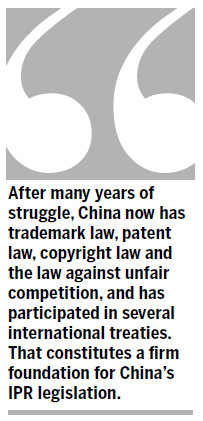Op-Ed Contributors
IPR progress remarkable
Updated: 2011-01-17 08:05
By Liu Chuntian (China Daily)

Progress in technology and economic development would be unimaginable without the legislation now in place
During the past three decades, China has made great progress in many fields, of which intellectual property rights (IPR) legislation is one. As a participator in, and witness to this progress, I think the process deserves our attention and approval.
In a sense, IPR was introduced from scratch in China, as the country's former planned economy was completely incompatible with this concept. The difficulties involved in introducing IPR protection in China would be unimaginable for most other countries, but China has accomplished this difficult mission. It is no exaggeration to say: IPR legislation is one of the greatest reforms in China in the past 30 years.
After many years of struggle, China now has trademark law, patent law, copyright law and the law against unfair competition, and has participated in several international treaties.
That constitutes a firm foundation for China's IPR legislation.
After joining international organizations, such as the World Trade Organization, China revised certain relevant laws to make them compatible with international standards. The patent law was revised in December 2008, while the trademark law is currently under the review.
However, writing laws is only the first step towards effective legislation. China also introduced reform in jurisdiction. Ever since the first court for IPR infringements was established in 1994, more jurisdiction workers have been trained to handle such cases. Currently the judges specifically dealing with IPR infringements number over 2,300, ruling on more than 30,000 cases a year.
The professional skills of judges have also greatly improved. Comparing the judgment documents of 1980s with those today, we can see how much progress the judges have made. Now Chinese judges are fully able to solve IPR infringements, even those involving complicated economic or legal problems. Today anyone can resolve IPR infringements through the courts.
Of course, IPR protection cannot rely on the legal system alone, it needs the joint efforts of the whole society. Here, there has also been great progress. Today IPR protection is already the common creed of most Chinese technology enterprises. Huawei, Lenovo, and Founder - all these domestic companies that rely on technology innovations have expressed their strong support for IPR protection. In recent years, especially, they have accelerated their pace in applying for patents and registering trademarks. Today China has the most registered trademarks in the world.
China has also firmly established IPR education. After being introduced in Renmin University of China in 1981, IPR education has been accepted by an increasing number of institutions of higher learning. Currently IPR courses are listed by more than 700 universities as core courses for law education, while more than 20 universities have established IPR schools. Every year Chinese universities honor thousands of students with IPR bachelor, master's or even doctoral degrees.
Science and engineering colleges have also strengthened IPR education for students. As potential or even actual patent holders, they have greatly strengthened awareness of IPR protection in the market.
IPR protection is already deeply rooted in China's legal system, making great contributions to economic and social progresses. It is hard to imagine that China's economic activities could go on today without IPR laws. Their role in promoting technology progress can never be exaggerated.
The author is an intellectual property rights professor with Renmin University of China.
(China Daily 01/17/2011 page8)
Specials

President Hu visits the US
President Hu Jintao is on a state visit to the US from Jan 18 to 21.

Ancient life
The discovery of the fossile of a female pterosaur nicknamed as Mrs T and her un-laid egg are shedding new light on ancient mysteries.

Economic Figures
China's GDP growth jumped 10.3 percent year-on-year in 2010, boosted by a faster-than-expected 9.8 percent expansion in the fourth quarter.